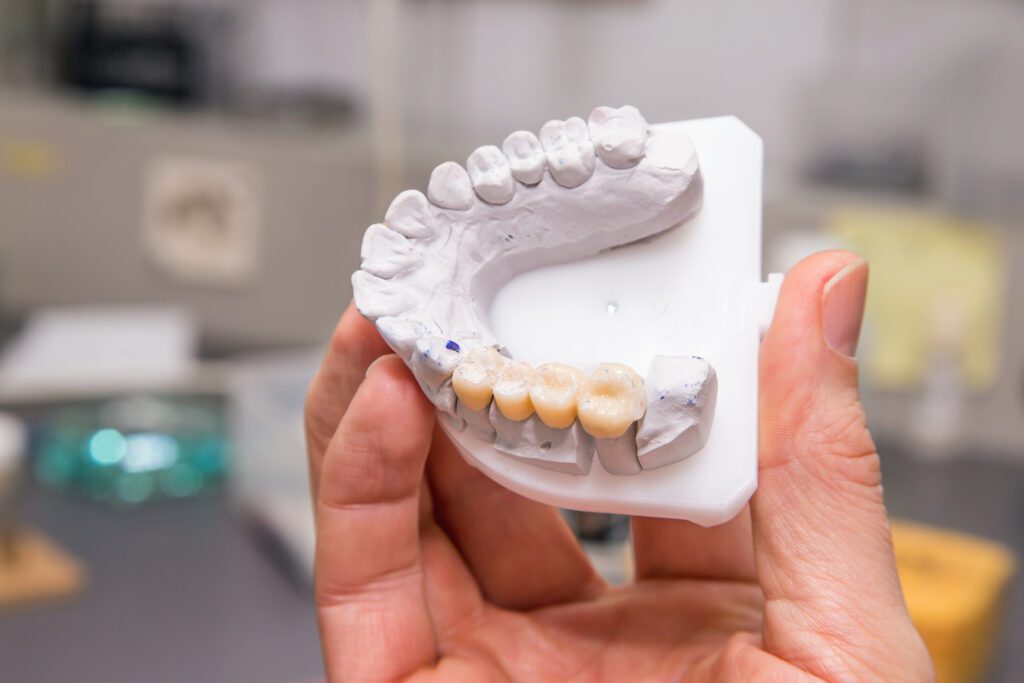Dental bridges are a great way to replace missing teeth. The treatment is a restorative dentistry procedure we offer to patients in Galveston, TX. A dentist will use your existing teeth to create a bridge to cross the area where your tooth is missing. Bridges are made from gold, metal, alloys, or porcelain to ensure they are strong and durable. Dental bridges can restore multiple missing teeth and improve the function and aesthetics of the smile.

Dental Bridge in Galveston, TX
The dentist begins by creating the abutments from your existing teeth to attach the bridge. Next, the dentist recontours the existing teeth to provide a base for the bridge. After we create the abutments, we will take a mold from the area and send it to a dental lab.
The lab can use the mold to create a bridge that fits properly and feels as close to your natural teeth as possible. The bridge consists of two crowns on either end to place on the abutments and a pontic, the new tooth that replaces your missing tooth.
We will fit you with a temporary bridge in our Galveston, TX, office while we wait for the lab to craft your permanent bridge. This will protect the abutments and the exposed gum areas and make it look more appealing than missing teeth.
After we create the permanent bridge, you will have a follow-up visit to set up the bridge. We will place it on the abutments, and the dentist will then use an adhesive to ensure the bridge is set.
The bridge may take a little while to adjust to. However, after a few days, it should feel like you have your own teeth back again. You should eat soft foods for the first few days after we place the bridge. After the initial phase, you can eat whatever you want without issues.
If you are missing a tooth, you should consider replacing it. Besides the aesthetic disadvantage of missing a tooth, it could also cause structural changes to your mouth and jaw, making eating or speaking difficult. Set up an appointment today to restore your smile.
Caring for Dental Bridges
You should brush the area gently and should not pull up on the tooth when flossing because it could become dislodged. The same goes for eating. You should avoid sticky or chewy foods while you have the temporary in.
There may be some sensitivity and irritation after they place the temporary or permanent. This is normal and will subside after the soft tissue heals. A warm salt water rinse will help, and you can also take Advil or Tylenol if the pain does not go away.
After the dentist places the permanent bridge, it may feel awkward for a few days. Your mouth needs to adjust to the new tooth, and it should feel like one of your natural teeth in less than a week.
If your bite feels abnormal, you should let your dentist know. Caring for your bridge is just like caring for your own teeth. You should brush and floss regularly.
Frequently Asked Questions
We will answer some of the most commonly asked questions our patients have about dental bridges.
Can dental bridges be whitened?
No, dental bridges can’t be whitened like natural teeth. The materials used in bridges, like porcelain or composite, don’t respond to whitening treatments. If your bridge no longer matches your teeth color, replacement is the best option for a consistent look.
What happens if you get a cavity under a bridge?
If a cavity forms under a bridge, the tooth structure beneath can decay and compromise the stability of the bridge. We will likely need to remove the bridge and treat the cavity, and we may need to replace the bridge if the tooth is still viable.
Will bridges feel like real teeth?
Dental bridges are designed to feel comfortable and natural in your mouth. While they may feel slightly different initially, most people adjust quickly. With time, a well-fitted bridge can feel almost like real teeth, making chewing and speaking easier.
Do dental bridges affect eating and speaking?
Dental bridges generally improve eating and speaking, especially if you’re missing teeth. A bridge restores chewing function and helps with clear speech. After an adjustment period, most people can eat and speak normally without difficulty.
How do I care for my dental bridge to ensure it lasts as long as possible?
To keep your tooth bridge in good shape, brush and floss daily, focusing on cleaning around and under the bridge. Use a floss threader or water flosser for thorough cleaning. Regular dental check-ups are also important to monitor the bridge and the supporting teeth.
How common is it for a dental bridge to fall out?
A well-maintained dental bridge is unlikely to fall out. However, factors like poor oral hygiene, gum disease, or damage to the supporting teeth can weaken the bridge’s stability. With good oral care and regular dental visits, bridges can last 10 to 15 years or more without issues.
Restore Missing Teeth Today
See if a dental bridge is the right treatment for your smile. Call Broadway Dental at 409-235-0789 or request a dental appointment online.
